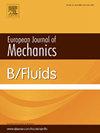Improved self-adaptive turbulence eddy simulation for complex flows and stall prediction using high-order schemes
Abstract
It is challenging to apply numerical simulations to accurately predict the stall behavior of aircraft equipped with high-lift devices. Simulations with Reynolds-Averaged NavierStokes (RANS) models suffer from lack of the reliability at high angles of attack with separated and reattached boundary layers, whereas wall-resolved Large Eddy Simulations (LES) of wall-bounded flows at high Reynolds numbers currently costs too much computational resources. A new unified hybrid turbulence modeling approach, denoted the Self-Adaptive Turbulence Eddy Simulation (SATES), is proposed and applied for complex turbulent flows combining with high-order numerical scheme of the Weighted Compact Nonlinear Scheme (WCNS) in the present study. It enables a seamless evolution from unsteady RANS to LES and finally approaches Direct Numerical Simulation (DNS) depending on the turbulent scales. In the framework of SATES, a new SATES-σ model with an adaptive model coefficient is developed by extending the underlying LES mode based on an enhanced sub-grid-scale model of the σ-model. The new SATES-σ is first examined in two benchmark cases of channel flow and flow past a square cylinder. Then, it is validated in supercritical flow past a circular cylinder to assess the performance of turbulent models. The results show significant improvements over the previous SATES and IDDES in the predictions of boundary layer flow. Finally, successful application is achieved in the accurate prediction of the stall of the MD-30P30N airfoil at a Reynolds number of 9×106 with wide angles of attack. The simulation results show good agreement with experimental results for surface pressure even for the challenging cases of 21 and 23 deg angles of attack. Again, the SATES-σ shows better results than the previous SATES and IDDES. The presented method has considerable potential for the challenging stall predictions.

 求助内容:
求助内容: 应助结果提醒方式:
应助结果提醒方式:


